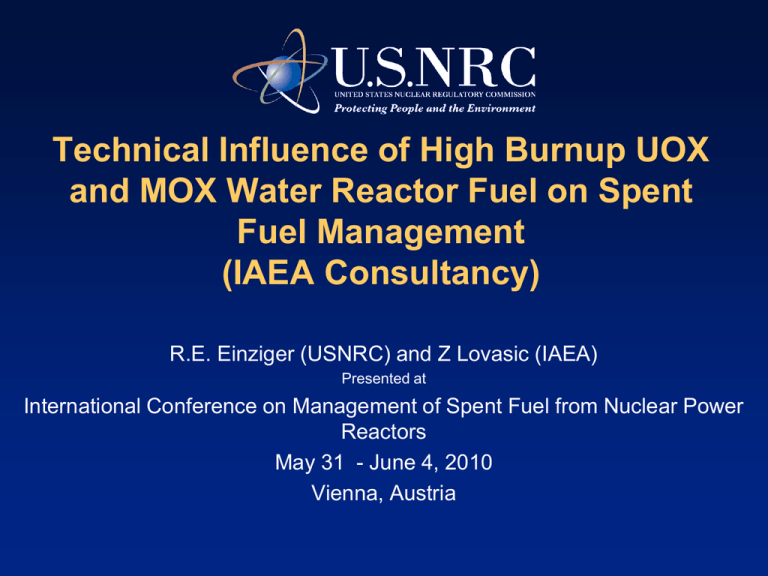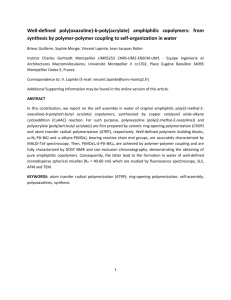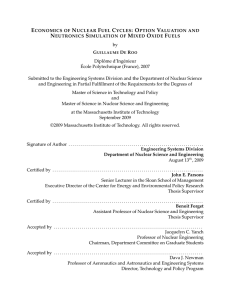IAEA Activities on Spent Fuel Management
advertisement

Technical Influence of High Burnup UOX and MOX Water Reactor Fuel on Spent Fuel Management (IAEA Consultancy) R.E. Einziger (USNRC) and Z Lovasic (IAEA) Presented at International Conference on Management of Spent Fuel from Nuclear Power Reactors May 31 - June 4, 2010 Vienna, Austria Main Contributors • W. Goll (AREVA NP GmbH, Germany) - Chair; • A. Kumar (Bhabha Atomic Research Centre, India); • S. Kusuno (Institute of Applied Energy, Japan); • N. Tikhonov (Federal State Unitary Enterprise Leading Institute, Russian Federation); • P. Cook (British Nuclear Group, United Kingdom); • J. Kessler (Electric Power Research Institute, United States of America); • R. Einziger (NRC, United States of America). 2 Purpose of the Work • Compile data on high burnup UOX and MOX fuels • Evaluate Potential Influence of high burnup UOX and MOX on spent fuel management • Make countries aware of the technical ramifications of the fuel changes for the back-end of the fuel cycle. 3 Assumptions in the Study • Only MOX and UOX were evaluated. • Only zirconium alloy clad oxide fuels have been considered. • Issues will be identified in general. Solutions will not be pursued. 4 UOX Fuel • The uranium is enriched up to 5% in PWR and BWR fuel and natural to slightly enriched in HWR fuel. • Most fuel rods are filled with helium gas • The PWR Zircaloy-4 was metallurgically treated in such a way as to form circumferential hydrides during irradiation, while the BWR Zircaloy-2 had a random grain texture. 5 The major differences between the high and low burnup LWR fuel • • • • Fissile content is higher Fission product content is higher, Fission gas pressure is higher, Cladding mechanical properties are different, • Fuel rim effect is greater. 6 MOX Fuel and UOX Fuel Comparison • Pellet and rod design of MOX fuels is generally similar to UO2 fuels • Increased MOX internal rod pressure • The mechanical design of MOX fuel assemblies is similar • Some MOX assembly designs include additional water rods to improve moderation • Rod placement in assembly 7 Fuel Characteristics not Considered in Evaluation • Unimportant – Cladding oxidation – CRUD – Pellet- cladding gap – Fuel rod bowing • Minor influence – Pellet fracturing – Fuel oxidation 8 What was considered in the investigation Neutronics Fission gas release Mechanical Properties of the Cladding Pellet Rim 9 Where high burnup affects the backend fuel cycle? Wet Storage Criticality Dry Storage Transportation Disposal Reprocessing L L,W L, W L,W L, W L, W L, W Heat removal L, W L Shielding L,H, W L, H, W L,H, W L,H, W L,H, W Containment/Confinement L?, H?,W L,H, W L,H, W L,H, W L,H, W Retrievability L, H,W L,H, W L,H, W L,H, W L,H, W L,H, W L,H, W Operations/construction L,H, W L = LWR fuel, H = HWR fuel, W = WWER fuel. 10 Wet Storage; Possible impacts of HBU UOX and MOX fuels • Upgrade of the pool facility with respect to heat removal, pool cleanup systems • Regulatory issues. • Criticality - additional neutron poison material in the pool water or in storage racks 11 Dry Storage and Transportation; Possible impacts of HBU UOX and MOX fuels • Redesign of the cask heat removal and shielding systems, • Decrease in the number of spent fuel assemblies that can be placed into a single transport /storage cask, • Increased decay time in the pool prior to placement in dry storage, • Redesign of the structural support for the spent fuel assemblies. • Lower maximum fuel temperature for MOX fuel 12 Reprocessing; Possible impacts of HBU UOX and MOX fuels • Redesign of some systems may be required. • Recalibration of radiometric instrumentation • Higher discharges into environment and HLW stream • Reprocessed MOX – additional challenges due to lower Pu solubility 13 Repository Possible impacts of HBU UOX and MOX fuels • Higher source terms of the radionuclides – potentially higher release to the groundwater, – additional shielding during spent fuel transfer from the transportation cask. • Higher temperatures – Smaller waste containers, – longer decay times at the surface prior to loading • Repository space may have to be increased or decreased depending if combined with reprocessing 14 REPU and MOX Fabrication Possible impacts of HBU UOX and MOX fuels • Different isotopic concentration in recycled fuel (less Pu-239, more Pu-238 and 240) • Increased enrichment of REPU or an increased amount of plutonium in MOX fuel is required to meet the same burnup target, • Increases in shielding may be required for REPU and MOX fuel fabrication operations. 15 Non-proliferation; Possible impacts of HBU UOX and MOX fuel • High burnup UOX, REPU, and MOX fuels tend to be more proliferation-resistant, because of the higher specific activity of each of these fuel types and because of less favourable fuel isotopics for proliferation (less Pu-239 and more Pu240 and Pu-238). 16 Conclusions • Experience has indicated the safe feasibility of using high burnup UOX and MOX fuels in the reactor, • It still appears that longer cycles, higher radiation and heat load may enhance some characteristics of SNF that could require additional attention and specific investigation in SNF management. 17









